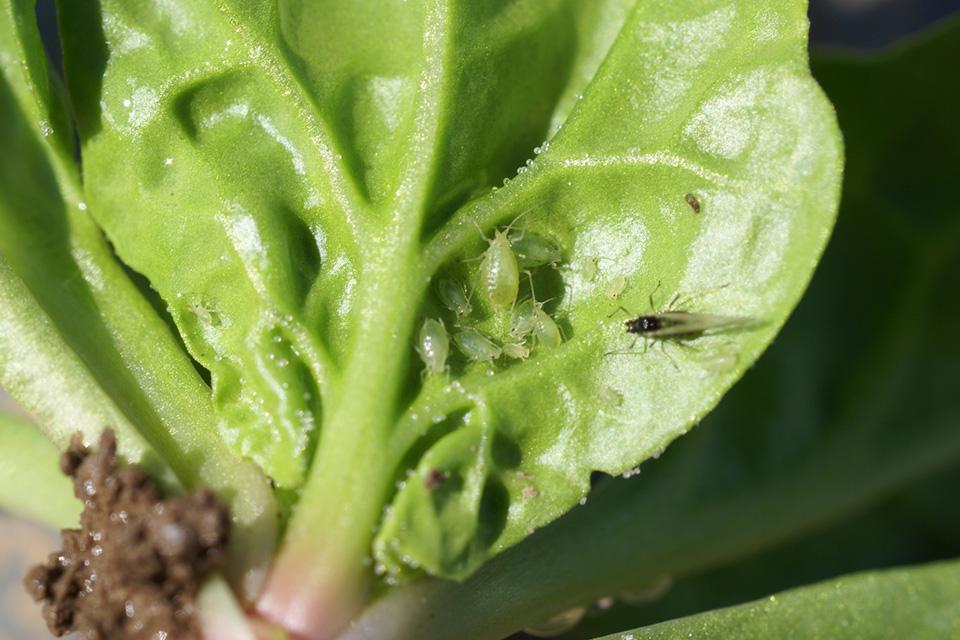Ways To Keep Spinach Crops Free of Aphids

Buyers will reject spinach hosting green peach aphids.
Photo: John C. Palumbo/University of Arizona
Aphids may be the most important insect pest found in spinach, particularly in fresh market spinach, with green peach aphid, Myzus persicae, considered the most economically important. Their ability to rapidly increase and contaminate harvestable leaves makes controlling aphids on spinach plants essential to avoiding crop losses. Cultural management tactics and natural enemies can reduce the impact of these pests, but you will likely need insecticides to prevent economic damage.
Aphid Biology
Green peach aphids are small, soft-bodied insects that have the potential to reach high densities under ideal conditions. Aphid life cycles are complex and vary considerably depending on growing region and climate.
In cropping systems with mild, temperate growing conditions (i.e., Coastal California and southern U.S.), green peach and potato aphids reproduce parthenogenically (asexually). Populations consist entirely of females that give birth to live female offspring. Green peach aphids tend to develop most rapidly when temperatures average about 55°F. Adult wingless (apterous) females give birth to live nymphs about 10 days after birth and can easily deposit 80 to 100 nymphs.
In climates with hard winter freezes, aphids will also reproduce sexually, and female aphids hatch from fertilized eggs laid on overwintering hosts plants.
Four nymphal instars occur with green peach aphid, each lasting about two to three days under ideal conditions. They develop rapidly, with more than 20 annual generations reported in temperate climates. Numerous overlapping generations can occur through the course of the season.
In response to crowding by other aphids or declining host plant quality, winged (alate) adult forms can disperse from field to field throughout a growing area.
Damage
Damage from aphids in spinach occurs in several ways.
Direct Feeding. Aphids have piercing-sucking mouthparts and feed on the phloem of spinach leaves by inserting their needle-like stylets into the plant’s vascular tissue. Accordingly, direct feeding on small plants by high aphid densities can cause wilting and stunted plant growth. Feeding by nymphs within crowns of young spinach plants can distort spinach leaves, resulting in downgraded quality. Or, if excessive, render product unmarketable.
Contamination. The most common economic damage stems from live aphids, exuviae, or honeydew contaminating harvestable foliage. Aphid populations initially colonize plant terminals, and if developed unchecked, can quickly infest harvestable leaves.
Excessive aphid feeding occasionally causes cosmetic blemishes to the plant tissue, usually in the form of yellow spots on leaves. Even a little aphid contamination and cosmetic injury to spinach leaves is not acceptable for most fresh markets.
Diseases. Green peach aphids can vector viruses that are pathogenic to spinach. Beet western yellows virus (BWYV), and cucumber mosaic virus (CMV) are the most common in spinach crops. These viruses will stunt plant growth and discolor leaves rendering them unmarketable.
Cultural Management
Preventing aphids from colonizing spinach plants is critical because of their potential to contaminate harvested leaves. Aphid infestations begin with winged adults moving in and giving birth to live nymphs.
Consequently, monitor fields regularly, beginning at seedling emergence through harvest. Yellow sticky traps can monitor movement of winged adults into an area. You can find small aphid colonies on spinach crops following sharp increases in the number of winged aphids caught on traps. Visually sample individual plants during scouting to detect winged adults and colonizing nymphs. Pay particular attention to young terminal growth.
Cultural control methods such as sanitation and destroying crop residue immediately after harvest can minimize the spread of aphids to adjacent plantings. Weedy mustards and members of the goosefoot family adjacent to fields can host high numbers of green peach aphids. Controlling these weeds helps prevent the buildup of green peach aphids and associated feeding damage and virus infection on nearby spinach crops.
Aphids have many natural enemies including lady beetles, lacewings, syrphid fly larvae, and numerous parasitoids such as Aphidius spp. and Aphelinus spp. Despite the large number of natural enemies that attack aphids, they rarely provide adequate control of high aphid populations in spinach crops.
Insecticides
High quality requirements for insect- and blemish-free spinach means insecticides are almost always necessary to prevent economic losses.
Foliar applied insecticides can manage green peach and potato aphids cost-effectively. Most of the newer insecticides, including sulfoxaflor (Sequoia), flupyradifurone (Sivanto Prime), pyrifluquinazon (PQZ), afidopyropen (Versys), spirotetramat (Movento), and flonicamid (Beleaf), are translaminar or systemic and selective against sucking insects. They are also easy on natural enemies, have low-risk environmental profiles, and provide effective residual control againt all aphid species found infesting spinach.
Initiate spray applications when aphids first begin colonizing plants. Furthermore, thorough spray coverage is necessary for effective insecticide performance, especially in high-density, baby leaf spinach crops.










